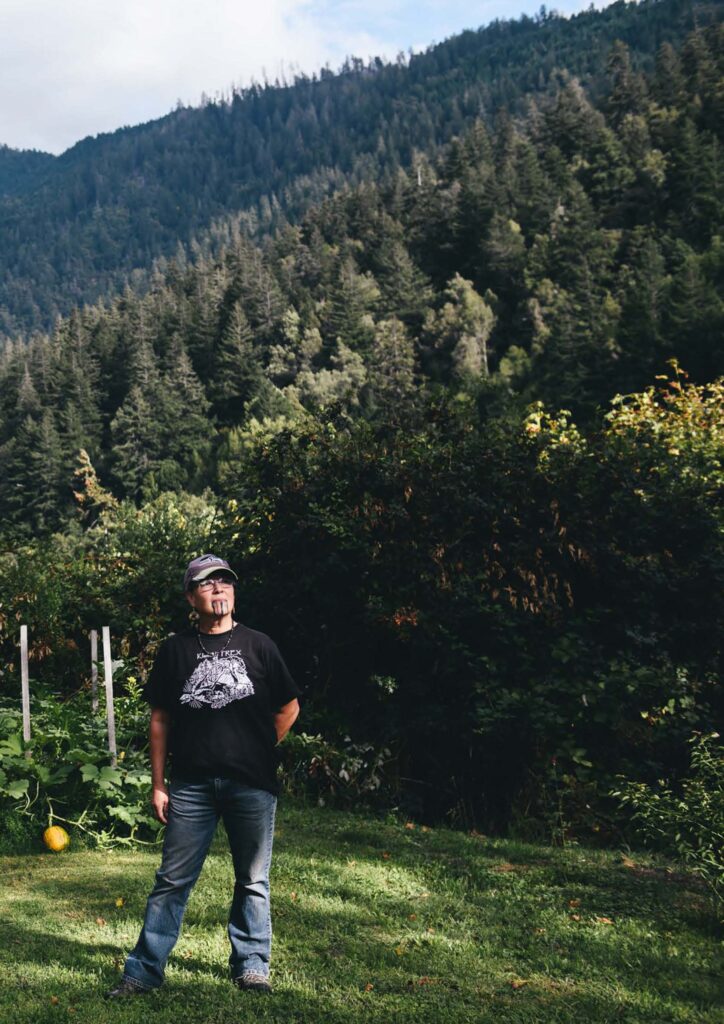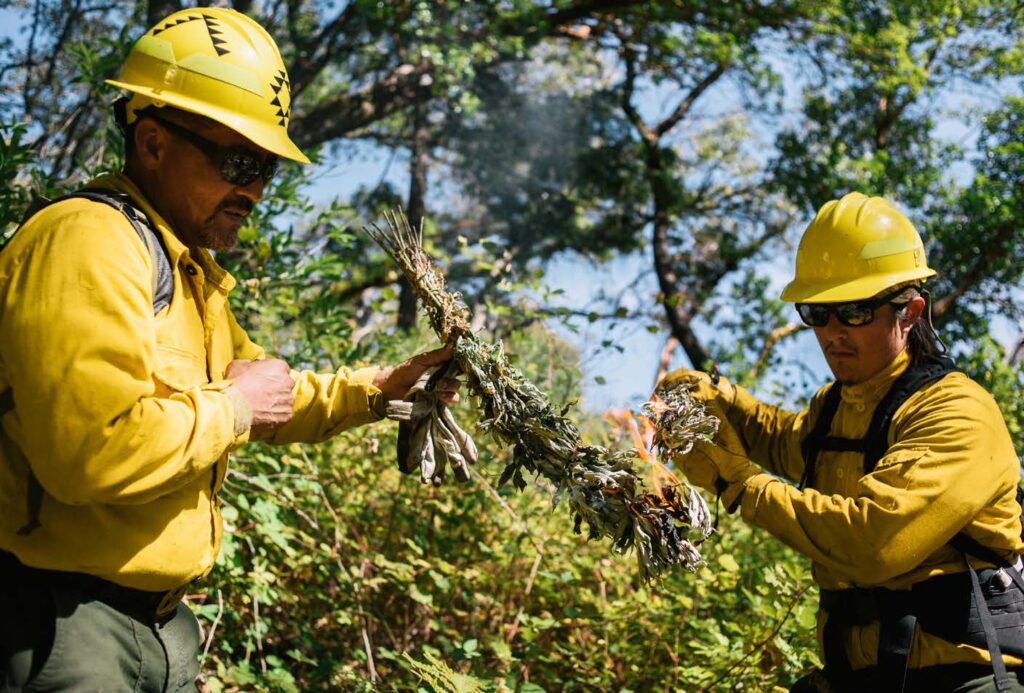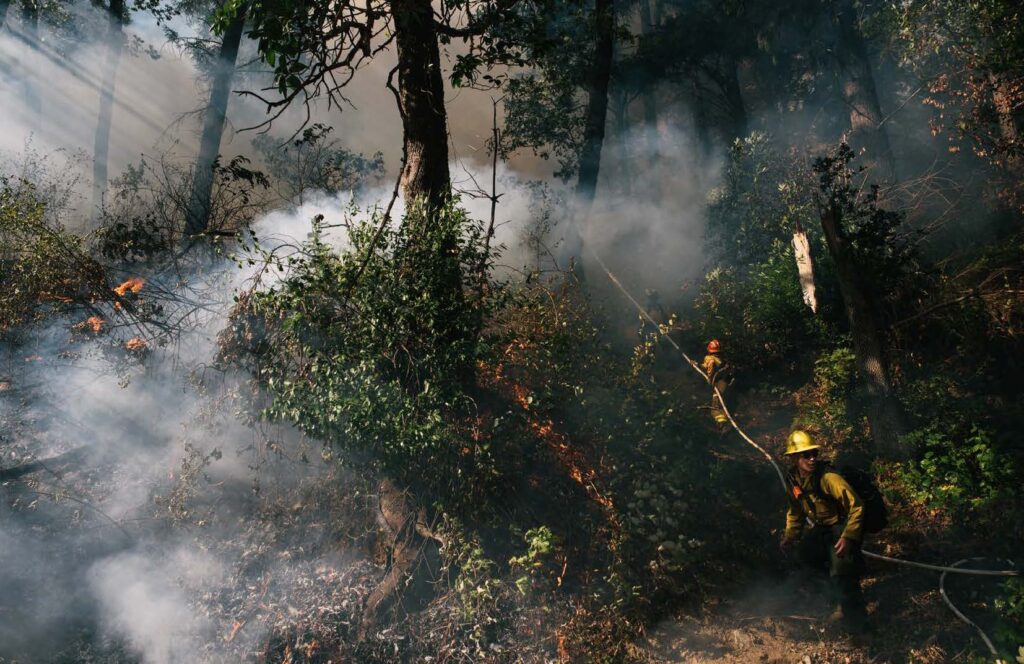Native American traditional burning was banned in California for decades, but today it’s being funded by the fire service as part of the US state’s fight against catastrophic wildfires

When European prospectors failed to find gold in the northwest coastal region of California, they plundered another natural resource: the great redwood forests, which at the time covered more than 2,000,000 acres. Forests were clear-felled on a huge scale to build San Francisco and other burgeoning cities. In 1918 a movement was set up to save them, but by the time Redwood National Park was created in 1968, 90% of the original forests had been cut down.
Yurok Territory
- Location: Northwestern Californian coast
- Type of landscape: Oceanic temporate rainforest, oak forest, prairie grassland
- Acreage: 98,000 acress
- Conservation measures: Prescribed burning, condor restoration, prairie restoration, invasive species management, Chinook salmon conservation
The fate of the trees in many ways mirrored the impact on California’s largest Native American tribe, the Yurok. When European settlers first arrived in the area, the Yurok, who numbered around 2,500, had been living in harmony with their natural surroundings for thousands of years. The giant redwoods in particular were central to their culture, both spiritually and practically, as the material for boats and houses. The Yurok regard the trees as living beings, guardians from a divine race that existed before humanity and showed them how to live at one with the natural world.
Inevitably, mass clearing of the forests led to conflicts, and native tribes were placed under huge pressure with many forcibly removed or killed. By 1895, only one-third of the Yurok tribe remained, but in spite of the persecution it survived and its members still live in the region today, keeping traditional practices alive. Tribal member Elizabeth Azzuz said: “Our ancestral territory is approximately 40,000 hectares and there are no towns or cities within its boundaries, only the mountains, rivers and forests. Many Yurok still make their dugouts and homes from our Guardian Trees.”
One ancient custom still practiced on tribal lands is the sacred rite of traditional burning. Burning was banned in all US National Parks in 1916 on the grounds that it damaged the soil, caused flooding and erosion, destroyed wildlife and habitat, and led to plant monocultures. However, science has since shown that in the Californian redwood forests it plays several vital roles in the ecosystem, including preparing a seedbed and helping germination and survival of giant sequoia seedlings, recycling nutrients, supporting wildlife, and creating a mosaic of vegetation ages and types. These findings align with Yurok understanding of the value of controlled burning, which is used to produce hazel whips, a key material for weaving. Elizabeth said: “We have carried out controlled burning for time immemorial. It encouraged hazel growth for basket making and bear grass, which was woven to adorn dresses and make baskets and necklaces. The spaces were good for wildlife, too, creating clearings where animals could find fresh forage.”

In 1850, the California State Legislature passed the Act for the Government and Protection of Indians, which outlawed intentional burning in California. The ban on controlled burns and attempts to suppress all wildfires and severe restrictions on tribal burning continued until the 1980s. This policy had two particularly disastrous consequences. One was the invasion of forests and coastline areas by invasive plant species; the other was the build-up of combustible vegetation or ‘fuel load’, which combined with global heating is now contributing to devastating wildfires. As a result, whereas native burning was previously outlawed, it is now actively encouraged and even funded by the authorities. Elizabeth said: “Due to the 100-year fire exclusion policy, we had to use our tribal sovereignty to get our burning done. However, the problem of wildfire has got worse in the past 20 years and burning is recognised as extremely important in mitigating the risks. No fuel means no wildfire, which is why Cal Fire funded our Cultural Fire Management Council (CFMC) to the tune of $1 million.”
This appears a big investment in prevention but pales compared with the cost of damage caused by wildfire. In 2020, the estimated cost to the state of California was $12 billion. It was by far the worst season on record, burning 4.3 million acres, killing 31 people, and destroying or damaging 10,000 buildings. 2020 was remarkable not just for the number of fires – almost 10,000 – but the scale at which they burned. Five of the six largest fires in the state were recorded. One blaze, the North Complex Fire, raced through 200,000 acres of dense woodland in 24 hours, killing 16 people. These fatalities were caused by the fires directly, but hundreds more excess deaths are thought to have resulted from smoke reducing air quality in cities. As for carbon release, the California Air Resources Board calculated that in 2020 wildfires emitted 111.7 million metric tons of carbon dioxide, producing more CO2 than every economic sector except transport.
In the context of the catastrophic damage caused by uncontrolled fires, the value of traditional burns in reducing the impact is clear both in terms of financial cost and carbon release. The recognition of the important part they can play has given the Yurok and their traditional practices a new respect. Elizabeth said: “We have great partnerships with the local fire agencies and now have a seat on many conservation panels and boards. In these challenging times, authorities are reaching out to the CFMC for direction.”

In turn, the Yurok community has benefited from investment in their skills, with jobs created in what is a remote and economically disadvantaged area. Elizabeth said: “Now that natives are allowed to burn, it’s become an important part of the local economy. The CFMC, which is a non-profit organisation with grant funding, employs 20 people in an area with 85% unemployment. We burn in spring and fall with crews of up to 50 people.” These burns only take place in very specific climatic conditions in order to reduce the surface vegetation without destroying the trees. They are tightly contained within small pre-selected areas, with firebreaks and firefighting equipment on hand to minimise the risk of spread.
Nature has always been tended by the people who dwell in her
Elizabeth Azzuz
As well as burning, the Yurok are permitted to take game and gather plants on their own and publicly held land. Elizabeth said: “We are a hunter/gatherer tribe. We have the right to fish our rivers and have permits to gather flora in California State Parks.” Their sense of an ancient connection to the landscape and its wildlife has instilled a deeply engrained culture of conservation and the Yurok are involved in a range of impressive community initiatives. Elizabeth said: “We do prairie restoration clearing historic pathways for elk and deer and we have two very big projects with our salmon restoration crews and condor re-entry scheme.” In the late 80s there were no Californian condor left in the wild, but thanks to a captive breeding and release programme, there are now more flying free than in captivity. Earlier this year, the Yurok’s proposal to build a captive breeding facility in Redwood National Park was accepted by the US Fish and Wildlife Service.
Redwood National and State Parks are both a UNESCO World Heritage Site and International Biosphere Reserve because they support globally important biodiversity including threatened species such as northern spotted owl, Steller’s sea lion, and Chinook salmon. But designations alone are not enough to restore damaged ecosystems. The Yurok have demonstrated that when local communities have a stake in the health of their natural surroundings and are freed from heavy-handed regulation to employ unique local knowledge, they can achieve real conservation success.
In future, Elizabeth would like tribal groups to be permitted to issue their own permits to burn without having to go through the current heavily bureaucratic process. She is calling for a more community-led approach to conservation, which acknowledges the place of humanity in the natural world and the role of land management. She said: “Humans are responsible for land; one doesn’t exist without the other. Nature has always been tended by the people who dwell in her. She cannot always clean herself. She needs a helping hand.”
Photos credit: Alexandra Hootnick
